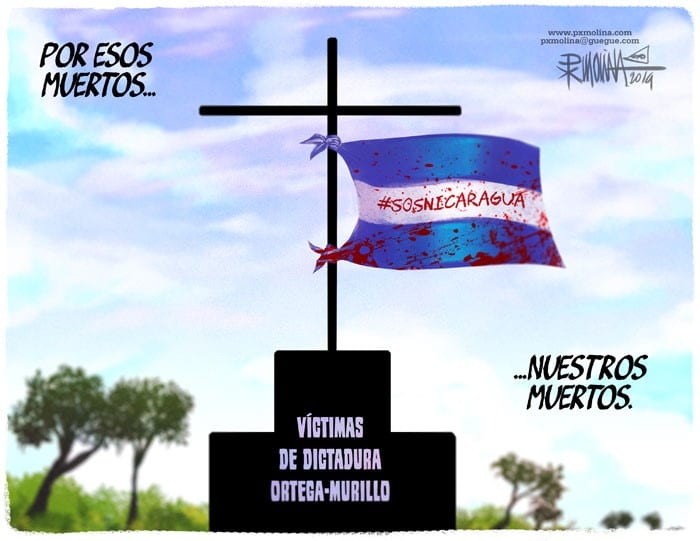Breaking Ortega’s Give and Take Game

Nicaragua’s Civic Alliance should call for a march for peace and freedom. If they refuse, then the Unidad Azul y Blanco movement should make the call.
Por Enrique Sáenz (Confidencial)
HAVANA TIMES – To retain his grip on state power, Ortega is deploying a strategy on multiple fronts. The negotiation table is just one of the arenas where Ortega plays and certainly not the only one. Therefore, if we hope to achieve freedom then we need to confront Ortega on all fronts.
Under current circumstances, the regime’s strategy rest on three main pillars: the negotiation table, domestic repression and communication.
Ortega was crystal clear that his main fear are international sanctions. The negotiation table is the resource that he draws to stall and eventually revert the sanctions against his regime.
The parties’ last agreement states that by suspending sanctions, foreign governments will “facilitate human, economic and social development in Nicaragua” and “favor those that are most vulnerable”.
Of course everybody knows this is all b******t. We all know that sanctions have been specifically tailored to target senior regime officials individually and their ill-gotten wealth.
Ortega and his acolytes have shown that the people’s well-being is of little concern, except only in demagogical speeches. For examples, one only needs to look at the plunder of Nicaragua’s Social Security Institute (INSS) and the ruthless reforms made to balance a deficit generated by corrupt mismanagement. These fiscal measures will only bring more unemployment, hardship and insecurity to the Nicaraguan people.
What they really care about is insuring their impunity and safeguarding their wealth. The recent fraudulent acquisition by the State of BanCorp is an example. The government’s daily ripping off of people through artificial gasoline prices is another.
Under these circumstances, Ortega’s goal by “negotiating” is to deceive, distract and divide. Through maneuvering and delays, he hopes to get away with his crimes. If we really want to take him on, we should continue working hard in the crucially important international front.
Just a few days ago, Ortega had three blows hand-delivered to him: the European Parliament’s declaration condemning him, the declaration of the UN Human Rights Council and the inclusion of the regime in the black list of human rights violators, along with Cuba and Venezuela, by the Inter-American Human Rights Commission. It is crucial that we exploit these opportunities.
The second pillar of Ortega’s strategy is repression. The regime is constantly abreast of popular mood and knows that people’s patience is again wearing thin. They know that a renewed protest movement will throw their strategy overboard. That’s why Ortega continues to repress.
There is a weak spot in this strategy that we need to fully exploit. For Ortega, it is crucial that people (abroad) believe that he is willing to negotiate all the while keeping street protests under control. To keep control of the streets, he has to maintain or increase his current levels of repression which undermines his credibility at the negotiation table.
If he yields, particularly by “allowing” freedom of expression, Ortega will be forced to loosen his social control strategy, opening a window for a new round of multitudinous street protests. This contradiction is one of his weaknesses.
If we can exploit Ortega’s double-bind, we will also derail his strategy. He will either have to give on one side or take on the other. We need to expose and defy him. We need to push him to the point where he has to yield on all sides.
A clear sign was the Unidad Azul y Blanco movement’s call to march on Saturday March 16, defying a police ban against public protests. The regime reacted by arresting nearly 200 people. International condemnation was swift and when the negotiations seemed on the brink of derailing, Ortega was forced to free all who were arrested in less than 24 hours.
The third pillar of Ortega’s strategy is communication. His intention is to project an image of a country that has returned to business as usual, in which Nicaraguans are solving matters among themselves. Domestically, he deploys this strategy through his privately-owned media and in social media, with the intent of spreading disinformation, intimidating opponents and assuring his supporters. This front is an especially difficult arena for Ortega but nevertheless we should not allow him to rear his ugly head.
So based on all of the above, what should the opposition strategy look like?
Number one: Keep up the international pressure and disclosure. Nicaraguan’s abroad here have a crucial role to play. They can’t cross their arms. They have to be proactive in constantly informing foreign constituencies and building ties with foreign parliamentarians, political leaders, NGOs and media.
Number two: Domestically, the opposition should increase their protest actions. Those courageous protesters who responded to last Saturday’s call for “picket protests” showed the way. We also need to improve our communication work.
Number three: Ortega calls for peace. He who has a monopoly of violence calls for peace. Very well then, let’s take him at his word.
We should pressure Nicaragua’s Alianza Civica into calling a march for peace and freedom. If they refuse, then let’s pressure the Unidad Azul y Blanco. We should convene national and international days of protests.
Let’s defy Ortega with a march for peace and liberty. We will see if he give or takes.





